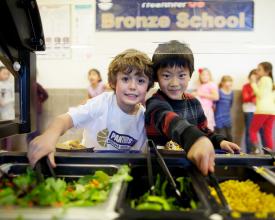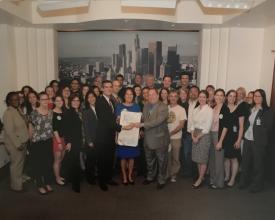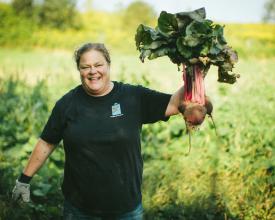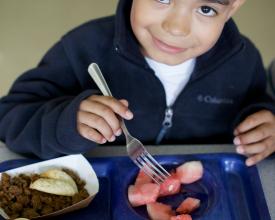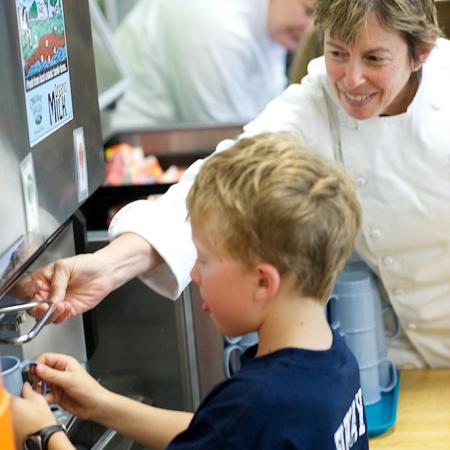
Programme d'achat de bons aliments (GFFP)
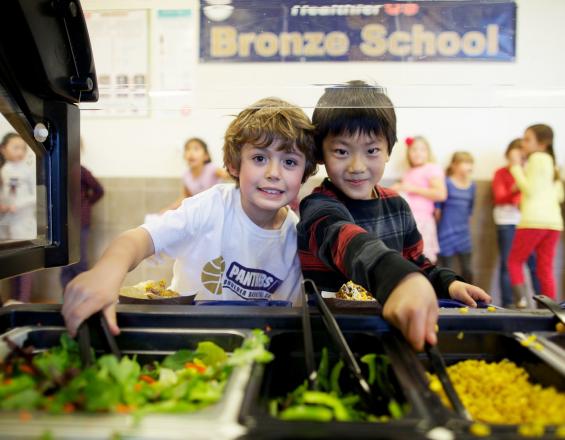
Adopté pour la première fois par la ville de Los Angeles en 2012, le programme d'achat d'aliments sains a permis aux enfants des établissements de Los Angeles, qui servent environ 750 000 repas par jour, de consommer davantage d'aliments locaux, durables, équitables et produits dans le respect de l'être humain. Le programme a déclenché un mouvement national et inspiré la création du Center for Good Food Purchasing, qui promeut actuellement le programme à travers les États-Unis. À ce jour, 27 institutions publiques dans 14 villes américaines y participent. En raison de ses réalisations impressionnantes et de son déploiement rapide dans tout le pays, le programme Good Food Purchasing a reçu une mention honorable du Future Policy Award 2018, décerné par le World Future Council en partenariat avec la FAO et IFOAM - Organics International.
Contexte
Défis à relever
La Californie est le cinquième fournisseur mondial de denrées alimentaires, de fibres de coton et d'autres produits agricoles, et le premier producteur de denrées alimentaires (en termes de volume) aux États-Unis. L'agglomération de Los Angeles est la deuxième région urbaine la plus peuplée du pays, avec 18,7 millions d'habitants. Pour lutter contre les systèmes alimentaires non durables, le maire de Los Angeles, Antonio Villaraigosa, a annoncé en septembre 2009 la création du groupe de travail sur la politique alimentaire de Los Angeles (Los Angeles Food Policy Task Force), qui a été chargé d'élaborer un programme politique de bonne alimentation pour Los Angeles. En 2011, le groupe de travail du LAFPC "Build a Market for Good Food" a élaboré les Good Food Purchasing Guidelines for Food Service Institutions, en collaboration avec des experts locaux et nationaux dans les domaines concernés. En 2012, le maire Villaraigosa a publié une directive qui s'applique à tous les services municipaux qui achètent pour plus de 10 000 dollars de denrées alimentaires, avec le soutien du conseil municipal de Los Angeles.
Emplacement
Traiter
Résumé du processus
En fixant les bons objectifs (BB1) et grâce à une large consultation des parties prenantes, le programme d'achat de bons aliments a été conçu, en utilisant un cadre flexible basé sur des mesures pour la mise en œuvre (BB2). La conception et le succès de sa mise en œuvre à Los Angeles et par le Los Angeles Unified School District ont renforcé son potentiel en tant que modèle transférable (BB3) et ont donné le coup d'envoi d'un mouvement à l'échelle nationale.
Blocs de construction
Objectifs
Adopté par la ville de Los Angeles en 2012, le Good Food Purchasing Program ® crée une chaîne d'approvisionnement transparente et aide les institutions à mesurer et à modifier leurs achats de denrées alimentaires.
Ses objectifs sont les suivants :
- Exploiter le pouvoir d'achat des grandes institutions pour encourager une plus grande production d'aliments durables, une alimentation saine, le respect des droits des travailleurs, le traitement humain des animaux et le soutien à l'économie locale des petites entreprises.
- Réorienter autant d'argent que possible vers la bonne alimentation afin de réaliser une économie d'échelle.
Facteurs favorables
Il s'agit du premier modèle d'approvisionnement qui soutient à parts égales cinq valeurs du système alimentaire : les économies locales, la durabilité environnementale, la valorisation de la main-d'œuvre, le bien-être des animaux et la nutrition, et qui encourage ainsi une myriade d'organisations à s'engager ensemble pour atteindre des objectifs communs.
Leçon apprise
En l'espace de six ans seulement, le programme "Good Food Purchasing" a eu un impact remarquable.
Ce programme a déclenché un mouvement national visant à mettre en place des politiques similaires dans des localités de toutes tailles et a inspiré la création du Center for Good Food Purchasing (Centre pour l'achat de produits alimentaires de qualité).
Utilisation d'un cadre flexible basé sur des mesures pour la mise en œuvre
Le programme d'achat de produits alimentaires de qualité, basé sur des mesures et un cadre flexible, encourage les grandes institutions publiques à mesurer leurs achats de produits alimentaires et à les modifier. En adoptant ce cadre, les établissements de restauration s'engagent à améliorer leur système alimentaire régional en mettant en œuvre des normes d'achat significatives dans les cinq catégories de valeur :
- Économie locale: le programme d'achat de produits alimentaires de qualité soutient les petites et moyennes exploitations agricoles et les entreprises de transformation alimentaire locales.
- Durabilité environnementale: le programme d'achat de produits alimentaires de qualité exige que les établissements se procurent au moins 15 % de leurs aliments auprès de producteurs qui utilisent des systèmes de production durables.
- Valorisation de la main-d'œuvre: la politique d'achat de produits alimentaires de qualité promeut des conditions de travail sûres et saines et une rémunération équitable pour tous les travailleurs et producteurs de la chaîne alimentaire.
- Bien-être des animaux: la politique d'achat de produits alimentaires de qualité promeut des soins sains et humains pour les animaux d'élevage.
- Lanutrition: Enfin, la politique d'achat de produits alimentaires de qualité promeut la santé et le bien-être en décrivant les meilleures pratiques qui offrent des portions généreuses de légumes, de fruits, de céréales complètes et d'aliments peu transformés, tout en réduisant la consommation de sel, de sucres ajoutés, de graisses saturées et de viande rouge, et en éliminant les additifs artificiels.
Facteurs favorables
Le programme Good Food Purchasing est considéré au niveau national comme la politique d'achat de denrées alimentaires la plus complète et la plus métrique du pays. La vérification, la notation et la reconnaissance sont des éléments centraux. Lorsqu'un établissement s'inscrit au Good Food Purchasing Program, le personnel du Center for Good Food Purchasing travaille avec lui pour recueillir des informations approfondies sur les pratiques d'achat et de service alimentaire.
Leçon apprise
Pour devenir un bon fournisseur de denrées alimentaires, l'établissement de restauration doit au moins atteindre le niveau de référence (égal à un point) pour chacune des cinq valeurs. Le respect de normes encore plus strictes permet d'obtenir davantage de points. L'accumulation des points pour toutes les valeurs est utilisée pour calculer et attribuer une note sous forme d'étoiles. Les critères d'achat de base et les critères plus élevés sont définis dans les normes d'achat de produits alimentaires de qualité, qui sont mises à jour tous les cinq ans, la dernière fois en septembre 2017. Il existe cinq niveaux de statut d'acheteur de produits alimentaires de qualité (de 1 à 5 étoiles) qui correspondent à une fourchette de points. Pour atteindre le niveau 5 étoiles, l'établissement doit obtenir 25 points ou plus. En juin 2018, cinq institutions sur 27 ont atteint un niveau d'étoiles, parmi lesquelles le Boulder Valley School District qui a obtenu 5 étoiles en 2017 et le Oakland Unified School District qui a obtenu 4 étoiles en 2016. Au bout d'un an, les acheteurs sont censés augmenter la quantité de Good Food qu'ils achètent.
Le potentiel d'un modèle transférable
Les services municipaux de L.A. et le LAUSD ont donné un exemple qui a depuis influencé de nombreuses autres régions des États-Unis. Le succès notable du Good Food Purchasing Program en 2012 a suscité un grand nombre de demandes d'assistance technique de la part d'autres villes et conseils de politique alimentaire désireux de mettre en œuvre des stratégies similaires. En effet, le programme a déclenché un mouvement national en faveur de l'adoption des normes du programme dans les localités, grandes et petites. Cela a conduit à la création du Center for Good Food Purchasing en 2015, une ONG qui possède et gère désormais le programme, ainsi qu'à son expansion à travers les États-Unis. À ce jour, 27 institutions publiques dans 14 villes américaines sont inscrites au programme, qui dépensent collectivement près de 895 millions de dollars en nourriture chaque année.
Facteurs favorables
Le programme est adaptable à des contextes spécifiques et de telles adaptations ont été utilisées pour faire progresser l'agroécologie, par exemple dans le comté de Cook. Selon l'équipe du Centre, le programme d'achat de bons aliments pourrait être appliqué partout, y compris dans les pays à faible revenu.
Leçon apprise
En 2018, plusieurs autres villes (San Francisco, CA ; Oakland, CA ; Chicago, IL ; Cook County, IL) ont adopté le programme d'achat de bons aliments et des campagnes sont en cours dans de nombreuses autres villes (Austin, TX ; Chicago, IL ; Cincinnati, OH ; Madison, WI ; Minneapolis/St. Paul, MN ; New York ; Washington, D.C. ; et Baltimore) pour faire pression en faveur de son adoption.
Le programme d'achat d'aliments sains a encouragé les élus et les fonctionnaires à réexaminer la manière dont ils peuvent utiliser les budgets publics pour mieux servir leur communauté. Ce changement fondamental de mentalité produira des résultats positifs importants pour les années à venir.
Impacts
Depuis 2012, le Good Food Purchasing Program a fait la différence dans tous les départements de la ville de Los Angeles et le LAUSD qui servent ensemble environ 750 000 repas par jour. L'étendue de son influence sur les chaînes d'approvisionnement alimentaire peut être mieux examinée en se concentrant sur l'exemple le plus marquant, le LAUSD qui sert plus de 600 000 étudiants. Le programme d'achat d'aliments sains a considérablement augmenté les achats de produits locaux durables du LAUSD. Au cours de la première année d'inscription, le LAUSD est passé de moins de 10 % d'approvisionnement en produits locaux à une moyenne de 60 % de produits locaux, réorientant 12 millions de dollars pour soutenir une production plus durable et éviter les longs itinéraires de transport. En conséquence, 150 nouveaux emplois bien rémunérés de la chaîne alimentaire ont été créés dans le comté de Los Angeles, notamment dans les domaines de la transformation, de la fabrication et de la distribution de produits alimentaires. Autre exemple, le distributeur de pain de LAUSD s'approvisionnait en blé hors de l'État pour ses 45 à 55 millions de dollars de petits pains annuels. Aujourd'hui, la plupart des petits pains du district scolaire de L.A. sont fabriqués à partir de blé cultivé dans 44 fermes californiennes certifiées par la Food Alliance, moulu dans le centre-ville de L.A., et les prix sont restés inchangés au cours des trois dernières années. Ces effets ne se limitent pas à LAUSD, puisque Gold Star Foods distribue désormais ces mêmes produits à plus de 550 écoles dans l'ouest des États-Unis.
Bénéficiaires
Les bénéficiaires sont des groupes vulnérables tels que les écoliers, les patients, les personnes âgées ainsi que les petites et moyennes exploitations agricoles locales et les entreprises de transformation alimentaire et leurs travailleurs.
Objectifs de développement durable
Histoire

Par Ann Cooper, chef cuisinier du district scolaire de Boulder Valley, qui a été le premier à recevoir une note de cinq étoiles du programme "Good Food Purchasing" :
La désignation du Boulder Valley School District (BVSD) comme le meilleur fournisseur de produits alimentaires de qualité prouve qu'il est possible pour les districts scolaires disposant d'un budget limité non seulement d'exceller, mais aussi d'ouvrir la voie à la mise en place d'un système alimentaire fondé sur les valeurs du programme, sans augmenter les coûts de l'alimentation. En achetant des produits alimentaires locaux, le BVSD a investi 890 700 dollars dans l'économie du Colorado, soit plus de 41 % de ses dépenses alimentaires totales, ce qui représente plus de 2,19 millions de repas par année scolaire. Près de 10 % de ces achats proviennent de petites exploitations agricoles locales situées à moins de 200 miles du district scolaire.
Comme le fait remarquer la chef Ann Cooper, ce sont ces producteurs régionaux qui aident le district à atteindre les objectifs fixés pour les cinq valeurs du programme Good Food Purchasing : "Il est vraiment difficile de ne choisir qu'un ou deux [producteurs locaux à récompenser]. Chef Ann a exprimé sa gratitude et ses compliments aux producteurs de viande du patrimoine, à une petite entreprise locale de tamales, à un courtier qui aide les petits producteurs à regrouper leurs produits afin qu'ils puissent les vendre au district, et à "neuf agriculteurs [qui] sont d'excellents partenaires de Good Food car non seulement ils nous fournissent des produits de la plus haute qualité, mais nous collaborons avec eux pour offrir des opportunités éducatives à nos élèves, à la fois dans les cafétérias et dans les exploitations agricoles. Nos agriculteurs travaillent dur chaque jour pour garantir à notre communauté l'accès aux aliments les plus nutritifs, tout en pratiquant une agriculture écologiquement durable et en soutenant le personnel avec des salaires équitables et décents".
Chef Ann souligne également le rôle important que le district peut jouer en offrant un certain niveau de certitude aux agriculteurs, même lorsque les conditions météorologiques menacent de dévaster les récoltes : "En ce moment, ce qui m'inspire le plus, c'est notre capacité à soutenir les agriculteurs locaux, même lorsque Dame Nature se bat contre eux, comme cela s'est produit avec plusieurs tempêtes de grêle cette année. Même si certains produits sont endommagés et peut-être invendables au marché, nous pouvons les acheter en grandes quantités pour aider nos agriculteurs à rester en activité. Et lorsque nous ajoutons à cela la possibilité de donner aux enfants des aliments délicieux et sains, nous sommes tous gagnants".

